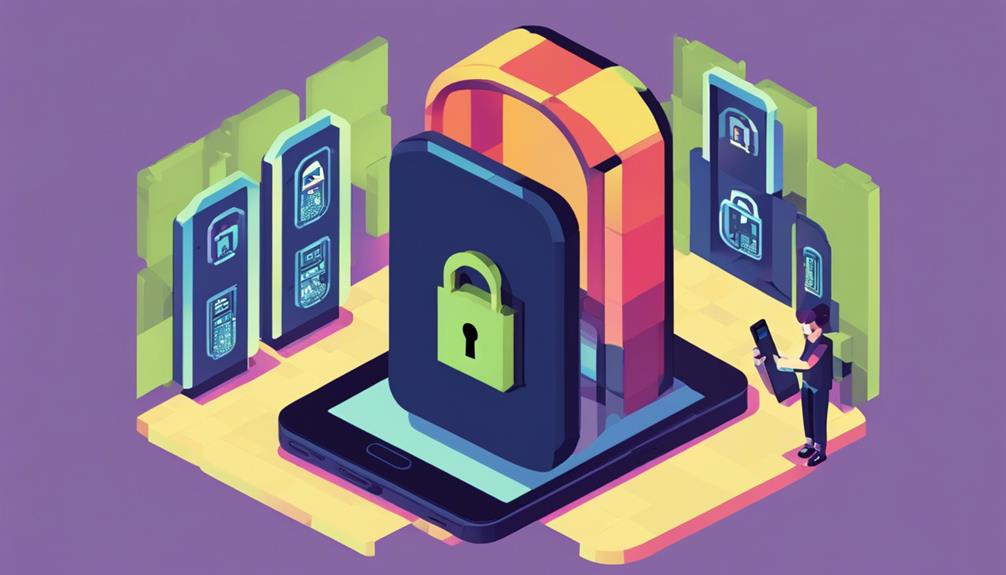Zangi App prioritizes security with top-level encryption like RSA-2048 and AES-256. It uses end-to-end encryption and a zero-knowledge policy for added safety. The app's serverless system and peer-to-peer tech enhance security. No data is stored on servers for better privacy. Additionally, local server installation boosts protection against hackers. Customizable privacy features and secure messaging abilities offer tailored security. Zangi's robust encryption methods guarantee data confidentiality. Its anti-phishing measures and high-quality communication make it a trusted option. The app's commitment to encryption protocols positions it as a reliable choice for secure communication.
Key Takeaways
- Zangi App employs top-level encryption technologies like RSA-2048 and AES-256 for maximum security.
- Local server installation enhances data protection and reduces vulnerability to external breaches.
- Customizable privacy features and encryption layers ensure user data confidentiality.
- Anti-phishing measures, end-to-end encryption, and a zero-knowledge policy safeguard against hacking attempts.
- Robust encryption methods, secure messaging abilities, and a serverless system prevent unauthorized access.
Top-Level Security Technologies
Moreover, the utilization of top-level security technologies in Zangi App serves as a robust defense mechanism against potential cyber threats. Zangi, a secure messenger renowned for its safety from hackers, employs advanced encryption methods like RSA-2048, AES-GCM, and AES-256 to protect user data.
By utilizing a serverless system and peer-to-peer technology, Zangi enhances its resistance to hacking attempts, ensuring privacy for its users. The app's zero-knowledge policy guarantees that only the sender and receiver can access encrypted messages, effectively safeguarding against hackers.
Moreover, Zangi's implementation of end-to-end encryption and dynamic channel encryption mechanisms adds an extra layer of security, making it a reliable platform for secure messaging. With no data stored on servers and a strong commitment to user privacy, Zangi stands out as a safe and secure messaging app that prioritizes protecting its users from potential cyber threats.
Customizable Features for Privacy

Zangi offers users the ability to customize their privacy settings to suit their needs. With options to adjust encryption levels and access permissions, individuals can tailor their security features.
These customizable privacy settings empower users to take charge of their messaging security and create a personalized secure communication environment.
Privacy Settings Customization
By allowing users to tailor their privacy preferences, Zangi's customizable features guarantee a personalized and secure messaging experience. Users can take advantage of encryption and other privacy settings to safeguard their communication.
These customizable options empower users to control who can access their messages, calls, and personal information within the app. With Zangi's privacy settings customization, users have the power to enhance their data security and protect their communication from unauthorized access.
The app's commitment to providing customizable privacy features not only offers a personalized experience but also ensures that users can adjust their settings according to their specific needs.
Security Feature Options
Users can customize a range of security features in Zangi to enhance their privacy and guarantee secure communication. The app offers end-to-end encryption and a zero-knowledge policy, ensuring that user data remains confidential.
By enabling secure 1:1/group calls, users can prevent middleman eavesdropping and communicate without concerns about privacy breaches. Zangi prioritizes user security by regularly updating its security measures to fend off hacking attempts effectively. Direct key exchange for secure calling further enhances the app's security features, safeguarding communication from potential threats.
In addition to these customizable security options, Zangi provides detailed Terms of Service and Privacy Policy documents. These resources offer users valuable information about the security features available within the app, empowering them to make informed decisions about their privacy settings.
Installation on Local Servers

Installing Zangi on local servers provides a robust approach to server security measures. This method guarantees secure data handling by keeping user information away from external servers.
Additionally, local server installation allows for thorough risk assessment procedures to safeguard user data against potential threats.
Server Security Measures
Local server installation of Zangi App enhances data security measures by providing users with greater control over server access and reducing the vulnerability to external breaches. This form of secure communication and data protection guarantees that user data remains within the user's control, minimizing the risk of unauthorized access.
With local server deployment, Zangi avoids storing user data on external servers, further safeguarding it from potential hacking attempts. By steering clear of cloud storage, the app reduces the exposure to external threats, enhancing overall data security.
Additionally, local server deployment adds an extra layer of protection against hacker attacks, making it a preferred choice for users prioritizing data security. Overall, Zangi's emphasis on local server installation underscores its commitment to ensuring the safety and confidentiality of user data, making it a reliable option for those seeking secure communication solutions.
Secure Data Handling
Enhancing data security measures, the Zangi app offers the option for businesses to install it on local servers for secure data handling. By choosing this feature, organizations can ensure that user data is not stored on Zangi servers, enhancing both security and privacy. This local server installation grants businesses full control over data management and protection, allowing them to customize security algorithms and encryption methods according to their specific needs. The Zangi app's focus on secure data handling ensures that sensitive information remains within the organization's secure network, minimizing the risk of data breaches and unauthorized access.
| Zangi App Data Handling Features | Benefits |
|---|---|
| Local Server Installation | Enhanced data security and privacy |
| No Data Stored on Zangi Servers | Reduced risk of unauthorized access |
| Customizable Security Measures | Tailored protection for specific needs |
| Full Control Over Data Management | Increased data control and oversight |
| Secure Network Environment | Minimized risk of data breaches |
Risk Assessment Procedures
Zangi's risk assessment procedures prioritize safeguarding user data through the implementation of installation on local servers for heightened security measures.
The Zangi Safe Messenger employs a serverless system, ensuring that user data is not stored on Zangi servers, thereby minimizing the vulnerability of data. This decentralized approach enhances protection against hackers by eliminating centralized data storage, reducing the risk of unauthorized access.
By adopting a serverless model, Zangi noticeably mitigates the chances of potential hacking attempts on user information. The Private Messenger's focus on local server installation underscores its commitment to robust security protocols, offering users a safer communication platform.
This risk assessment strategy aligns with Zangi's dedication to providing a secure messaging environment that prioritizes user privacy and data protection. Through these measures, Zangi continues to fortify its defenses against cyber threats, fostering a trustworthy and secure messaging experience for its users.
Data Not Stored on Zangi Servers

How does Zangi guarantee the security and privacy of user data through its unique approach of not storing any information on its servers?
Zangi implements a serverless system, ensuring that no data is stored on Zangi servers, including user messages and files. This innovative approach eliminates the risk of data breaches and hacking attempts on centralized servers.
By utilizing an encrypted proprietary handshaking mechanism, known as Zangi Data, user information is securely transmitted without being stored externally. As a result, hackers are unable to access communication history or sensitive data since there is no stored information to compromise.
This serverless model not only enhances data protection but also safeguards user privacy by preventing unauthorized access. Zangi's commitment to keeping user data off servers ensures that personal information remains secure and inaccessible to cyber threats, providing users with a reliable and secure messaging platform.
Secure Messaging Abilities

Zangi App's secure messaging abilities are fortified by robust encryption methods like RSA-2048 and AES-GCM.
Users have control over privacy settings, ensuring the confidentiality of their conversations.
Anti-phishing measures further safeguard messages from malicious third-party interference.
Encryption for Messages
By employing a sophisticated array of encryption technologies, the Zangi App guarantees the utmost security for messages exchanged between users. The app's implementation of end-to-end encryption ensures that only the sender and receiver can access the content, safeguarding it from any potential breaches. Multiple encryption layers, such as RSA-2048, AES-GCM, and AES-256, further enhance the security of messages, making it extremely difficult for unauthorized parties to intercept or decipher the communication.
Zangi's serverless system and proprietary encryption mechanisms work in tandem to protect messages from hacking attempts.
The app utilizes a customized TLS/Noise protocol for secure messaging, adding an extra layer of defense against any unauthorized access.
With its zero-knowledge policy, Zangi ensures that user data remains confidential and inaccessible to any third parties, guaranteeing the privacy of its users.
Privacy Settings Control
Users can personalize their privacy settings within the Zangi App to enhance their secure messaging abilities. This control includes options like anonymous registration, guaranteeing user anonymity and security.
The app's end-to-end encryption and serverless system prevent hackers from intercepting messages, providing a secure communication environment. Zangi goes a step further by implementing military-grade security measures such as RSA-2048, AES-GCM, and customized TLS/Noise encryption protocols. These robust mechanisms safeguard user data from unauthorized access and ensure message confidentiality.
Moreover, Zangi's zero-knowledge policy adds an extra layer of security by ensuring that only the sender and receiver can access the messages, keeping them safe from external threats. This commitment to privacy and data protection makes Zangi a reliable choice for secure communication, reducing the risk of hacking incidents.
Anti-Phishing Measures
How does Zangi App guarantee secure messaging abilities through its anti-phishing measures?
Zangi App maintains safe messaging by implementing robust anti-phishing measures to protect user data and communications.
- End-to-end encryption and advanced encryption types like RSA-2048, AES-GCM, and AES-256 are used to safeguard messages from phishing attacks.
- Secure messaging abilities of Zangi prevent hackers from intercepting or altering communications, maintaining a safe messenger environment.
- Zangi's zero-knowledge policy restricts access to message content solely to the sender and receiver, thwarting phishing attempts.
- The app's serverless system and peer-to-peer technology enhance security, preventing phishing attacks on user data.
These anti-phishing measures, combined with constant security updates and encryption protocols, establish Zangi as a reliable and secure platform for private messaging, protecting users from potential threats posed by hackers.
High-Quality Audio and Video Calls

With a focus on guaranteeing excellent communication quality, Zangi app offers high-quality audio and video calls fortified by military-grade security measures.
The Zangi messenger ensures that users can engage in private messaging through encrypted end-to-end calls, preventing any interception or eavesdropping by hackers.
Additionally, Zangi incorporates a proprietary handshaking mechanism that enables secure direct key exchange during calls, enhancing the overall security of the communication.
In addition, the dynamic channel encryption further fortifies the security of audio and video calls on the Zangi platform, ensuring that users can enjoy crystal-clear communication without worrying about hacking risks.
Low Bandwidth Consumption Mode

Efficiently designed to accommodate areas with limited Internet connectivity, Zangi's low bandwidth consumption mode optimizes data usage for seamless communication. Users can enable this feature to minimize mobile data consumption while enjoying private messaging and calls.
Here are some key points regarding Zangi's low data usage mode:
- Allows for efficient communication in areas with limited Internet connectivity.
- Minimizes mobile data consumption during messaging and calls.
- Helps save data costs by reducing the amount of data used.
- Guarantees uninterrupted communication by optimizing data usage.
With Zangi's focus on low data usage, users can stay connected without worrying about excessive data consumption. This feature makes Zangi an ideal choice for individuals in remote locations or areas with congested networks, providing reliable messaging and calls while being mindful of data usage.
Focus on Anonymity During Registration

Zangi App places a strong emphasis on user anonymity during the registration process, offering options that prioritize privacy and security. One key feature is the ability to sign up without providing a personal phone number. By allowing email registration as an alternative to phone number verification, Zangi ensures that users can create accounts without compromising their anonymity.
This focus on anonymity is essential, especially for those seeking private messaging capabilities without revealing personal information. Users appreciate the choice to maintain their privacy by not linking their phone numbers to the app. Zangi's commitment to safeguarding user data is evident in the registration process, where steps are taken to prevent the exposure of personal phone numbers.
This approach not only enhances user anonymity but also provides a secure environment for communication within the app.
Trusted Option for Secure Communication

Utilizing military-grade security measures, Zangi App provides a trusted option for secure communication, guaranteeing user data remains protected from potential hackers.
Zangi Private guarantees end-to-end encryption, safeguarding messages and calls from unauthorized access.
Zangi users benefit from proprietary handshaking mechanisms that establish secure connections, further enhancing the app's security features.
Dynamic channel encryption adds an extra layer of protection by constantly changing the encryption keys used for communication, making it challenging for hackers to intercept data.
Additionally, the serverless system of Zangi means that no user data is stored on Zangi servers, reducing the risk of hacking attempts.
With these robust security protocols in place, users can enjoy peace of mind while communicating securely through Zangi App.
Is Zangi App Safe From Hackers?

With an unwavering focus on security and privacy, Zangi App is designed to withstand hacking attempts and guarantee user data remains protected.
The app employs military-grade encryption mechanisms, such as End-to-End encryption and proprietary handshaking, to establish secure communication for private messaging.
Zangi's serverless system and dynamic channel encryption further diminish the risk of hacking attempts, making it a reliable option for secure communication.
Additionally, the app's one device policy and no data stored on servers policy notably prevent unauthorized access by hackers.
Zangi's commitment to privacy and security, along with its zero-knowledge policy, adds an extra layer of protection, safeguarding user information from hacking threats.
Frequently Asked Questions
Is Zangi Messenger Safe From Hackers?
Zangi Messenger is fortified against hackers with end-to-end encryption, RSA-2048, AES-GCM, and AES-256 protocols. Its serverless design and dynamic channel encryption bolster security, while a zero-knowledge policy safeguards user data from unauthorized access.
Is Zangi a Real App?
Zangi is a genuine messaging app with robust security features like military-grade encryption and serverless operation. Its focus on privacy and data security, along with proprietary encryption mechanisms, guarantees a safe user experience.
What Country Is Zangi From?
Zangi, a trailblazing communication app, originates from the United States. Developed by a team of secure communication technology specialists, Zangi guarantees data security by dispersing servers globally. With robust encryption, Zangi prioritizes user privacy and security.
Which Country Uses the Zangi App?
Zangi app is utilized by individuals in multiple countries worldwide due to its secure messaging capabilities and encryption features. Users from diverse regions rely on Zangi for safe communication, ensuring their data remains protected.
Conclusion
To sum up, the Zangi app utilizes top-level security technologies, customizable features for privacy, and secure messaging abilities to protect user data from hackers. While no system is completely invulnerable, Zangi's focus on anonymity during registration and data not being stored on their servers adds an extra layer of protection.
One potential objection could be the lack of widespread recognition compared to other messaging apps, but Zangi's reputation for security makes it a trusted option for secure communication.









